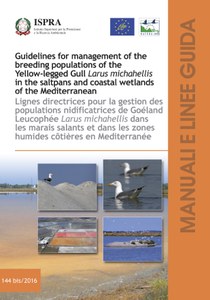Guidelines for management of the breeding populations of the Yellow-legged Gulls Larus Michahellis in the saltpans and coastal wetlands of the Mediterranean
Lignes directrices pour la gestion des populations nidificatrices de Goéland Leucophée Larus Michahellis dans le marais salants et dans les zones humides cotières en Mediterranée
The Yellow-legged Gull (Larus michahellis) showed a large population increase across most of its breeding range in the past 30-40 years, mirroring the trend of other large gulls in Northern Europe, North America, and Australia. Due to their synanthropic habits, dominance in colony site occupation, and excellent predation attitude, the rise of large gull populations has resulted in widespread conflicts with the conservation of other bird species, the management of protected areas, and several human activities.
The significant increase of large gull populations has been largely driven by two coexisting factors: the decrease of direct human persecution on gull colonies throughout vast parts of the breeding range and the increase of highly predictable food supplies derived from human activities (i.e. refuse and fishery discards). Coastline stabilisation works carried out to prevent sea intrusion improved Yellow-legged Gull colonisation of lagoons where the water level is more predictable and contributed to its geographic expansion. Since these causes are unlikely to cease in the near future and conflicts with this species are currently perceived as unsustainable in several Mediterranean areas, the creation and delivery of management guidelines for the Yellow-legged Gull is particularly urgent.
These Guidelines are aimed at gathering and delivering all the experiences about Yellow-legged Gull management that have been acquired before and during specific projects on the species that were carried out in the Mediterranean area. Specifically, special attention is devoted to projects involving breeding gull populations or carried out on salt-pans and coastal wetlands. Historically, Mediterranean wetlands are at the centre of conflicts between human activities and conservation issues, mainly in sites of community importance (SCI) and linked to implementation of the Birds Directive.
Therefore the delivery of sound conservation and management practices to stakeholders is the main goal of this publication.
Download the publication (pdf 22 Mb)

